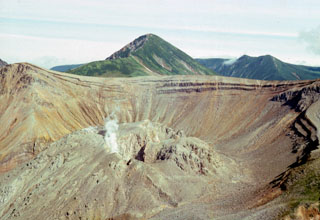Report on Kolokol Group (Russia) — 26 August-1 September 2009
Smithsonian Institution / US Geological Survey
Weekly Volcanic Activity Report, 26 August-1 September 2009
Managing Editor: Sally Sennert.
Please cite this report as:
Global Volcanism Program, 2009. Report on Kolokol Group (Russia) (Sennert, S, ed.). Weekly Volcanic Activity Report, 26 August-1 September 2009. Smithsonian Institution and US Geological Survey.
Kolokol Group
Russia
46.042°N, 150.083°E; summit elev. 1328 m
All times are local (unless otherwise noted)
Based on analyses of satellite imagery, SVERT reported that on 26 August a gas-and-steam plume possibly containing ash rose from Berg (part of the Kolokol Group of volcanoes) to an altitude greater than 6 km (19,700 ft) a.s.l. and drifted NE.
Geological Summary. A group of Holocene volcanoes in central Urup Island is named after its most prominent volcano, Kolokol. Berg and Trezubetz volcanoes, flanking Kolokol on the NW, have breached summit calderas partially filled by lava domes. Trezubetz, whose name means "Trident," has an eroded crater rim with three large peaks when seen at sea from the north. Kolokol is sometimes known as Urup-Fuji because of its symmetrical profile. The crater of Kolokol is not well preserved, but there is no evidence of glacial erosion. Several lava flows originate from Kolokol; one of these extends almost to the Sea of Okhotsk coast; a viscous lava flow armoring the SE flank is probably the most recent. Borzov volcano, the oldest of the group, lies to the SW of Kolokol. Eruptions have been observed since the late-18th century. Berg volcano has been most active, but Trezubetz erupted in 1924.

